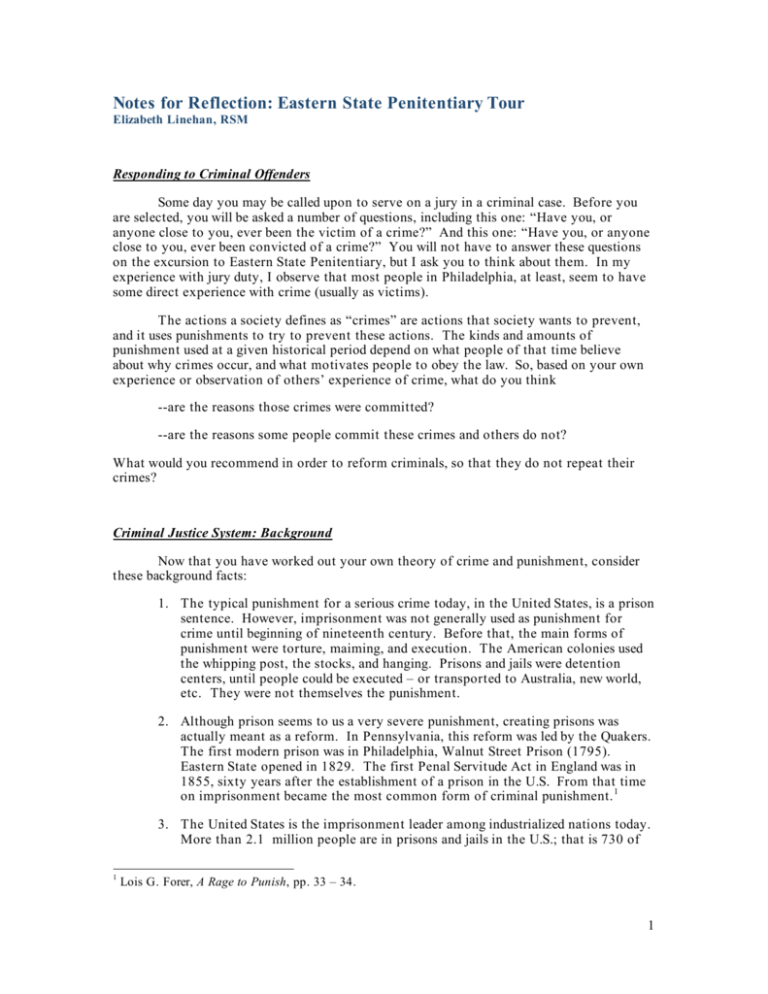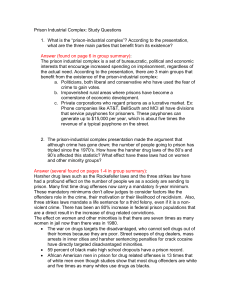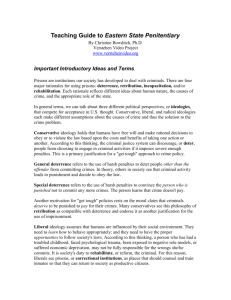Notes for Reflection: Eastern State Penitentiary Tour
advertisement

Notes for Reflection: Eastern State Penitentiary Tour Elizabeth Linehan, RSM Responding to Criminal Offenders Some day you may be called upon to serve on a jury in a criminal case. Before you are selected, you will be asked a number of questions, including this one: “Have you, or anyone close to you, ever been the victim of a crime?” And this one: “Have you, or anyone close to you, ever been convicted of a crime?” You will not have to answer these questions on the excursion to Eastern State Penitentiary, but I ask you to think about them. In my experience with jury duty, I observe that most people in Philadelphia, at least, seem to have some direct experience with crime (usually as victims). The actions a society defines as “crimes” are actions that society wants to prevent, and it uses punishments to try to prevent these actions. The kinds and amounts of punishment used at a given historical period depend on what people of that time believe about why crimes occur, and what motivates people to obey the law. So, based on your own experience or observation of others’ experience of crime, what do you think --are the reasons those crimes were committed? --are the reasons some people commit these crimes and others do not? What would you recommend in order to reform criminals, so that they do not repeat their crimes? Criminal Justice System: Background Now that you have worked out your own theory of crime and punishment, consider these background facts: 1. The typical punishment for a serious crime today, in the United States, is a prison sentence. However, imprisonment was not generally used as punishment for crime until beginning of nineteenth century. Before that, the main forms of punishment were torture, maiming, and execution. The American colonies used the whipping post, the stocks, and hanging. Prisons and jails were detention centers, until people could be executed – or transported to Australia, new world, etc. They were not themselves the punishment. 2. Although prison seems to us a very severe punishment, creating prisons was actually meant as a reform. In Pennsylvania, this reform was led by the Quakers. The first modern prison was in Philadelphia, Walnut Street Prison (1795). Eastern State opened in 1829. The first Penal Servitude Act in England was in 1855, sixty years after the establishment of a prison in the U.S. From that time on imprisonment became the most common form of criminal punishment. 1 3. The United States is the imprisonment leader among industrialized nations today. More than 2.1 million people are in prisons and jails in the U.S.; that is 730 of 1 Lois G. Forer, A Rage to Punish, pp. 33 – 34. 1 every 100,000 people incarcerated. Russia is second, with 607/100,000 incarcerated. For Canada, by contrast, the number per 100,000 is 116. [These are 2004 statistics; if anything, the numbers for the U.S. have increased since then.] 4. Most of the men and women in prison in the U.S. have committed nonviolent offenses, especially drug crimes. 5. It would be a great oversimplification to say that the United States has so many people in prison because it has so much crime. This is too simple for two reasons: first, because a society decides what to count as a “crime.” The crime rate may increase because activities that were not criminal before have been redefined as criminal (e.g., sale of alcoholic beverages during Prohibition). Second, one of the major reasons so many people are in prison is the trend to long, mandatory sentences. 6. Prison sentences in the U.S. are, in general, the longest in the industrialized world.2 Increased use of a “life without parole” sentence will widen this gap. In many European nations it is not even permitted to sentence someone to life imprisonment. Goals of Imprisonment We will be visiting a museum that, for most of its existence, was a prison. So, thinking of a prison sentence as a response to crime, reflect on the purpose or purposes of keeping people confined in this way. What’s the point? What good is it supposed to do, for the offender or for the rest of society? What do you think about how effective prisons are at achieving their goal (or goals)? What I am asking here is your own opinion. To aid your reflection, it might be useful to mention some goals that societies at different times have had in mind. They include: • Reform of the criminal • Protection of society from dangerous persons • Deterrence – of the criminal himself, from future crimes, and of others who see what happens when one commits a crime • Justice, in the form of retribution • Reparation to the state and to direct victims Which of these goals has been given the greatest importance has varied over time. The priority of a particular goal makes a difference. It dictates a number of concrete aspects of a prison system, such as length of sentences, programs and activities available to prisoners, and even the physical structure of the buildings themselves. This is very apparent in the history of Eastern State Penitentiary. Eastern State Penitentiary 2 The United States also stands pretty much alone in that world in its use of the death penalty. 2 The tour will provide rich historical detail about Eastern State Penitentiary. Even more important, it will give you a “feel” for the experience of those imprisoned there. These few historical details are useful for you to have beforehand: In 1787 the Pennsylvania Society for Alleviating the Miseries of Public Prisons, 3 under the leadership of Benjamin Rush, proposed the idea of building a prison in Philadelphia that would be a model for the world, of humane and enlightened treatment of criminal offenders. The project was supported by important colonial leaders, such as Benjamin Franklin. After lobbying the Pennsylvania legislature for more than thirty years, the prison was finally built, on a hill outside the city. It was originally designed to hold 250 inmates. Eastern State Penitentiary opened in 1829 and attracted immediate international interest as a new model of incarceration. This model, based on isolation in order to induce repentance, was referred to by its architect as “a forced monastery.” Unlike other prisons of the time, Eastern State did not permit any corporal punishments. In that sense, at least, it was comparatively humane. The Eastern State Penitentiary web site notes that in the 19th century most prisons in the world were built according to one of two models: the “Pennsylvania model” of Eastern State, and New York state’s Auburn System. In contrast to the solitary confinement that was the heart of the Pennsylvania model, the Auburn System was a “congregate” model. Eastern State continued to operate as a prison until 1971, but the solitary model was abandoned much earlier (officially, in 1913; in practice, before that). By 1926 it housed 1,700 inmates; by this time a number of new cell blocks had been built. In 1956 Cell Block 15, Death Row, was added. After the Tour Based on what you’ve learned and thought about, what do you now see as the most effective and most humane way for our society to respond to those who commit criminal offenses? 3 This organization still exists, as the Pennsylvania Prison Society. It is dedicated to prison reform and social justice. 3









